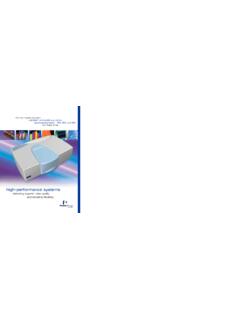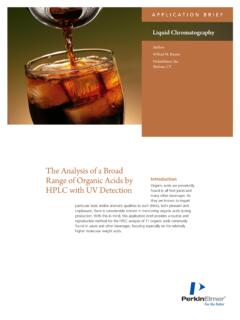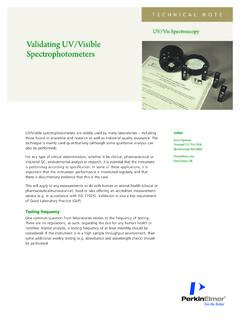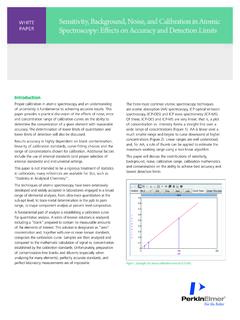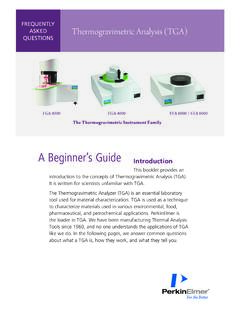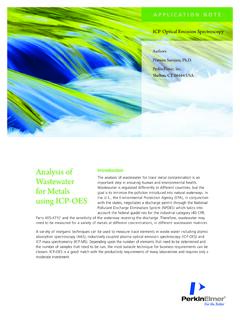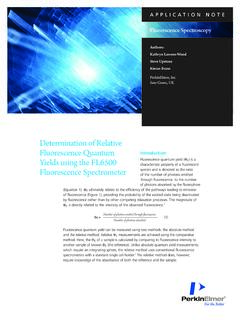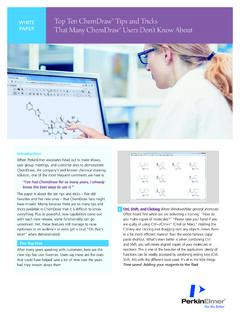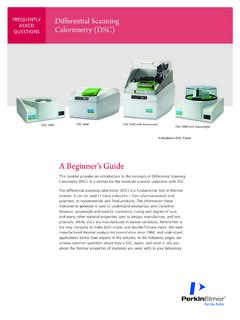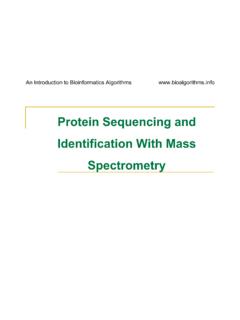Transcription of PinAAcle 500/900 AA Spectrometers - PerkinElmer
1 APPLICATION NOTEA tomic AbsorptionPREPARING YOUR LABThis document provides detailed instructions regarding the space, accessories and utilities required to operate PerkinElmer s PinAAcle 500 and 900 family of atomic absorption (AA) Spectrometers , THGA and HGA graphite furnace systems, and other major AA AA instruments are complete systems with the exception of the following items which must be provided by the analyst: suitable working area; exhaust vent(s); gases and regulators; and light sources. When a THGA or HGA graphite furnace system is being used, additional items may be required, which are described in Section 8.
2 General information on each of the required items is given in the appropriate section of this Checklist Suitable working area Exhaust vent Atomic absorption gases Handling of gas cylinders and safety practices Drain vessels Graphite furnace and flame requirements Facilities requirements Important accessories and consumablesPinAAcle 500/900 AA SpectrometersPinAAcle 500 Flame AA SpectrometerPinAAcle 900 Series AA Spectrometers21 Suitable Working AreaThe environment in which any instrument is housed is an important consideration.
3 The room temperature should be between 15 and 35 C (59-95 F) with a maximum rate of change of 3 C (5 F) per hour. For optimum instrument performance, the room temperature should be controlled at 20 +/-2 C. The instrument should be located away from direct sources of heat or cold. The relative humidity should be between 20 and 80%, relatively dust-free environment is necessary. This is especially important when working with ultra-trace techniques, such as graphite furnace sampling. Other important considerations are to locate the instrument in an area free of corrosive fumes and vibration and in an area that does not receive direct sunlight.
4 This precision instrumentation is not designed to withstand vibrations from earthquakes. The instrument should be located away from radiators and at least 6 feet away from any A/C or heating Spectrometers are normally installed on laboratory work benches or tables. The benchtop or area in which the AA instrument is to be installed should be large enough to accommodate the instrument and all accessories (dimensions of those items are given in Section 10). A custom PinAAcle heavy-duty rolling bench, with locking casters and a lower shelf for storage, can be ordered (Part No.)
5 N0777783). Make sure that there is space at the rear and sides of the system for air to circulate freely. Do not block the fan operating on both sides of the instrument. The back of the instrument should not be placed permanently against a wall, as the instrument must be accessible from the back for servicing purposes. An accessible space of at least 60 cm (24 in.) should be available behind the instrument. If this is not possible, the table or bench on which the instrument is mounted should be on wheels so that it can be easily moved.
6 The vent drop should be flexible so that it can be moved out of the way when the instrument is serviced. It is much easier to install and service an instrument that is on a rolling means of electrically grounding the instrument and all accessories must be available. Atomic Absorption System LayoutIn addition to the basic requirements for atomic spectroscopy systems, preparation of your laboratory for atomic absorption (AA) Spectrometers equipped with graphite furnaces requires that consideration be given to the installation needs of the furnace power : The use of atomic absorption instruments without adequate ventilation to outside air may constitute a health hazard.
7 For example, the combustion of halogenated hydrocarbons produces toxic vapors. Extreme care should be taken that exhaust gases are vented properly. FIAS (flow injection for atomic spectroscopy) systems and flame autosamplers should be placed on a cart or table close to the AA spectrometer sample compartment to keep FIAS and/or autosampler tubing to a minimum length. The FIAS system and/or autosampler can also be placed to the side of the instrument however, maximum performance may be compromised due to the increased length of tubing required.
8 With self aspiration of the nebulizer, the uptake rate is greatly affected by the length of the Exhaust VentA venting system is required to remove the combustion fumes and vapors from the flame or graphite furnace for AA instruments. Exhaust venting is important for a number of reasons: It will protect laboratory personnel from toxic vapors which may be produced by some samples. It will tend to remove the effects of room drafts and the laboratory atmosphere on flame stability. It will help to protect the instrument from corrosive vapors which may originate from the samples.
9 It will remove dissipated heat which is produced by the flame or flow rate of approximately 5700-8500 L/min (200-300 cubic feet/min) is required for air/acetylene flame and 1000 L (35 cubic feet/min) is recommended for furnace operation. A flow rate of approximately 7000-8500 L/min (250-300 cubic feet/min) is required for nitrous oxide/acetylene flame operation. Though we do not specify a maximum flow rate, more than 20% above the recommended flow rate of 300 cubic feet/min will also affect stability of the flame, thus the precision of measurement.
10 It is strongly recommended that the instrument not be placed in a chemical hood! If a chemical hood must be used, arrangements should be made to keep out corrosive vapors and backdrafts from other preparation should not be carried out in the same hood where the instrument is 1. Blower and vent kit offers an accessory, Blower and Vent Kit (Part No. 03030448 for 230 VAC; Part No. 03030447 for 115 VAC), which will fulfill the exhaust requirements for all AA instruments (see Figure 1). The blower capacity is for one instrument. Included in the kit are a rotary blower with capacitor and hardware, a vent to be located above the instrument, and an adapter to permit connection of the blower and vent with suitable metal tubing.
